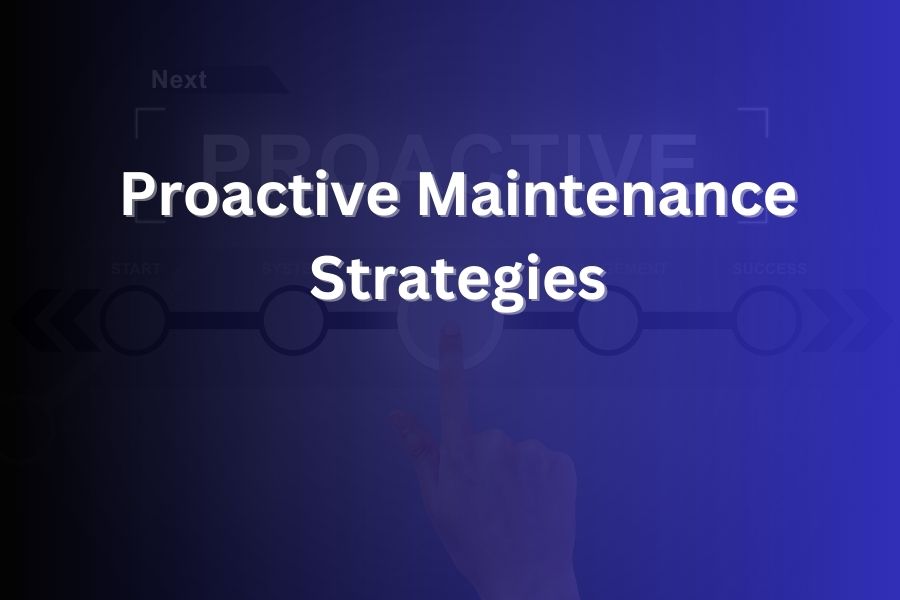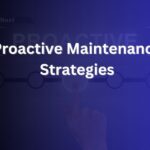When you implement proactive maintenance strategies you position your organization to halt failures before they happen and preserve asset performance. A forward-looking maintenance program drives efficiency, cuts unexpected downtime and safeguards safety.
In this article, you will learn how to define proactive maintenance, build a strategy tailored to your operation, leverage technology and training, measure success and maintain continuous improvement.
What Does Proactive Maintenance Mean?
Proactive maintenance means taking maintenance actions before equipment fails rather than reacting afterward. It focuses on identifying root causes of wear, misalignment, lubrication issues or sensor anomalies and removing them. Rather than waiting for breakdowns it aims for prevention, reliability, and operational continuity. You move from running to failure into sustaining peak performance.
Why Proactive Maintenance Matters
If you rely purely on reactive fixes you incur higher costs, lost production time and safety risks. Proactive maintenance delivers:
- Reduced unplanned downtime and improved uptime.
- Longer asset life and reduced replacement frequency.
- Enhanced safety and fewer emergency work orders.
- Better maintenance cost control and budget predictability.
Studies show proactive approaches often cut downtime by 30-50% and lower repair costs significantly.
For a U.S. manufacturing plant these gains translate into millions in savings and better competitiveness.
Key Types of Proactive Maintenance
Understanding the types helps you design the right program. The main ones are:
- Preventive maintenance: Scheduled tasks at fixed intervals (calendar or usage-based) to keep assets healthy.
- Condition-based maintenance: Monitoring equipment condition (via vibration, oil analysis, infrared, etc.) to intervene when signs of trouble appear.
- Predictive maintenance: Using real-time data, analytics and algorithms to forecast failures and schedule work only when needed.
These types often overlap, and you’ll typically employ a hybrid approach.
Building Your Proactive Maintenance Strategy
Here is a practical roadmap for transforming your maintenance approach. Each step builds on the previous.
- Assess your current state
You begin by auditing existing assets, failure history, maintenance records and downtime events. Identify critical equipment, unreliable parts and failure-modes. Rank assets by risk (impact of downtime, cost of failure, safety consequences). - Prioritize assets and failures
Once you know which assets pose the greatest risk or cost, assign priority levels. Critical machines get higher attention and investment; less-critical ones may continue under simpler routines. This ensures your resources focus where they matter most. - Define key performance indicators (KPIs)
Set KPIs to measure success. Examples: Mean Time Between Failures (MTBF), Mean Time To Repair (MTTR), percentage of reactive work orders, planned versus unplanned maintenance ratio, asset availability, maintenance cost per unit. These metrics help you quantify progress and justify investment. - Develop maintenance plans
For each asset group assign the appropriate maintenance type and tasks. Preventive: schedule lubrication, belts, filters, general inspection. Condition-based: install sensors or manual inspection protocols. Predictive: establish data collection, analytics, and trigger thresholds. Create work orders, define schedules and assign roles. - Implement supporting technology
A robust computerized maintenance management system (CMMS) or enterprise asset management (EAM) software becomes the backbone. It logs asset history, schedules tasks, tracks parts and labour, and produces reports. Add condition-monitoring sensors, IoT devices and analytics tools as your strategy matures. - Train and build a maintenance-first culture
Your workforce plays a crucial role. Technicians must understand how to interpret condition data, use the CMMS, act on alerts and perform root cause analysis. Encourage operators, supervisors and maintenance staff to treat maintenance as everyone’s responsibility, not just the technicians. - Monitor, evaluate and refine
A proactive maintenance strategy does not succeed overnight. Review your KPIs regularly, analyse failure causes, track trends and refine tasks, schedules and tools. Use continuous improvement to reduce unnecessary work, optimize intervals and drive cost reductions.
Overcoming Common Challenges
You will encounter hurdles on the journey. Here are common issues and how to handle them.
Challenge: High initial cost and complex setup
Installing condition sensors, analytics platforms and training staff requires investment. You justify it by prioritizing critical assets first and building a phased plan. Early wins build momentum and support.
Challenge: Data overload or poor data quality
Sensors generate a lot of data. Without proper cleaning or analytics you may drown in information. Focus first on key parameters, define thresholds and build dashboards that give actionable insights rather than raw numbers.
Challenge: Cultural resistance
Maintenance teams used to reacting may resist the change. Leadership needs to communicate the benefits, provide training and celebrate early successes. Transparency and inclusion help adoption.
Challenge: Balancing preventive and predictive tasks
Over-scheduling preventive tasks can lead to wasted effort (so-called “PM creep”). Under-scheduling risk unplanned breakdowns. Use your KPIs and data-feedback loops to adjust. Let condition-based and predictive methods guide you toward optimal intervals.
Technology and Tools That Enable Proactive Maintenance
Modern maintenance strategies leverage digital tools to provide a competitive edge:
- CMMS/EAM that houses asset data, work orders, maintenance history and KPIs.
- IoT sensors for vibration, temperature, oil chemistry, pressure, flow and other indicators of equipment health.
- Analytics platforms and machine learning applications to detect patterns, predict failures and trigger maintenance tasks.
- Mobile devices and apps that allow technicians to access asset history, receive alerts, fill reports and initiate work orders in the field.
- Dashboards and reporting systems that translate maintenance data into business intelligence for operations, finance and management.
Measuring Success: How You Know Your Strategy Works
You measure success through consistent tracking of your KPIs. Some strong indicators of impact:
- Decrease in unplanned downtime hours.
- Increase in planned maintenance percentage vs reactive work orders.
- Reduced maintenance cost per unit of production.
- Improvement in asset availability and reliability metrics.
- Extended life of equipment and reduction in replacement frequency.
For example, one case study noted a 30-50 % reduction in downtime after implementation of a proactive maintenance program.
Best Practices for U.S.-Based Facilities
Here are practical best practices tailored to U.S. operations:
- Align maintenance strategy with regulatory compliance, safety standards and OSHA requirements.
- Choose scalable technology that suits your budget and operational size – many CMMS platforms offer modular solutions for small and large facilities.
- Focus on key assets first – target those with the highest cost of failure or safety implications.
- Keep the language and training materials clear, standardized and accessible for a diverse U.S. workforce.
- Use benchmarking: compare your metrics with industry peers to set realistic goals.
- Integrate maintenance planning with production schedules – coordinate to minimise disruption during day shifts.
- Establish a clear spare-parts inventory strategy: critical parts on hand to prevent delays, non-critical parts via just-in-time procurement.
- Use seasonal planning to account for weather, peak production cycles, supply-chain constraints and labour availability.
Sustaining the Strategy Over Time
To keep your proactive maintenance strategy delivering long term value you must foster sustainability. Consider the following:
- Leadership buy-in and cross-departmental collaboration. Maintenance is not isolated – it intersects with operations, finance, safety, procurement and IT.
- Continuous training and development of new maintenance personnel. Technology evolves and your team must stay up to date.
- Periodic review of asset criticality: as production changes, equipment roles may shift. Update your asset prioritisation accordingly.
- Use the maintenance data you collect to feed capital expenditure decisions. Forecast replacement needs and avoid surprise investments.
- Celebrate improvements and document results. This reinforces the value of the proactive program and enhances adoption across your workforce.
- Re-invest part of your maintenance savings into further improvements: additional sensors, predictive analytics or maintenance staff enhancements.
Conclusion
Adopting proactive maintenance strategies is a smart business decision. You reduce downtime, control costs, extend asset life and improve safety. By assessing your current state, prioritising assets, defining KPIs, leveraging the right technology, training your team and continuously refining your approach you build a maintenance culture that sustains performance.
If you start with your most critical assets and scale intelligently you’ll achieve measurable returns. Embrace the shift from reactive to proactive maintenance and position your operation for reliability and growth.







